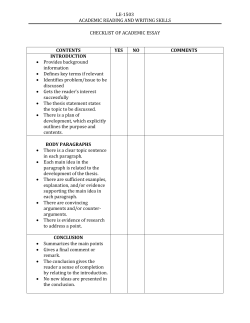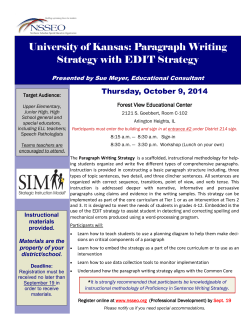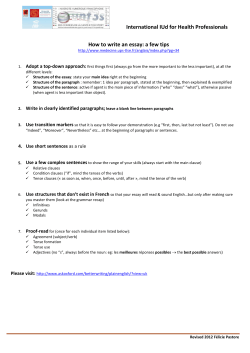
Middle School Science Fair Project Packet
FREDERICK K.C. PRICE III CHRISTIAN SCHOOLS ANNUAL SCIENCE FAIR MIDDLE SCHOOL INFORMATION PACKET PROJECT DUE FRIDAY APRIL 17, 2015 Middle School Science Teacher: Ms. Dianne Coe March 6, 2015 Subject: 2015 Science Fair Dear Parents/Guardians: It is with great pleasure that Frederick K.C Price III, Christian Schools announces our Annual Science Fair. The Fair will take place on Friday April 17, 2015 in the Youth Activity Center. There will be times available for viewing and a separate time for judging the projects. We encourage you to assist your child in researching and preparing this project. During the next few weeks, your child will design a science project that uses the Scientific Method to solve a problem. We trust you agree that the educational benefits are numerous, as students develop skills in writing, oral presentation, creative thinking, problem solving, understanding cause and effect relationships, keeping records, and budgeting time to meet specific deadlines. Each student has been given instructions and handouts (attached) for various steps of his or her project. Most of the work will be completed at home. We ask that you encourage your child and monitor his or her progress along the way. Your support is crucial to a successful project. However, please do not allow your involvement to extend any further in order to assume equity and promote student learning. It is important that your child wrestle with problems and try to solve these problems for themselves. Please, guide your child wherever you can, but let the final project reflect your child’s individual effort and design. Also, keep in mind that a successful project does not have to cost an enormous amount of money. Should you have any questions, please direct your questions to Ms. Coe, via email at dcoe@faithdome.org or you may leave a message in the main office for me at 323-565-4199. Thank you Dianne Coe Middle School Science Teacher 2 SCIENCE FAIR 2015 SAFETY PRECAUTIONS AND MANDATORY REQUIREMENTS SAFETY PRECAUTIONS 1. 2. 3. 4. 5. 6. 7. No hazardous liquids No dangerous materials may be exhibited No open flames Electrical devices must be safe No wet cell devices No containers of mold (however, photos or drawings are acceptable) No live animals may be brought to school ( however, photos, or drawings or observation notes are acceptable) 8. Water and other liquids used may not be brought to school (however, photos and or drawings are acceptable) MANDATORY REQUIREMENTS 1. A threefold display board 2. A written report 3. Model and or pictures of experiment on board Example of Science Fair Display SCIENCE FAIR REPORT 1. Title Page: The title of the project should be centered on the page, the name of the student must not appear here 3 2. Hypothesis: The hypothesis is the scientist’s (your child’s) prediction of what they believe will happen, using “If and then….” This is a single sentence 3. Materials and Procedure: The materials and procedure should be listed in bulleted format; use past tense, passive voice (e.g., “the solution was mixed,” not: I mixed the solution) . Remember the scientific point of view is impersonal, therefore, avoid using first person pronouns ( I, me, mine). 4. Results and Analysis: The results and analysis will be written after the experiment is complete. Use past tense, passive voice (e.g., “measurements of the stem diameter were taken,” not: I measured the diameter of the stems, “) 5. Conclusion: The conclusion explains how you interpreted your results and statistical analysis. The conclusion should first be stated in one sentence that parallels your hypothesis in content and structure. Three paragraphs must be used to further explain your conclusions. References should be made to similarities and differences between your findings and interpretations. WHAT IS THE SCIENTIFIC METHOD? The Scientific Methods Features These Steps: Question/Purpose: Identify the problem. What do you want to find out? Hypothesis: Make an intelligent guess, what do you think will happen? Materials: Gather materials needed to do the experiment. What materials do you need to use? Procedures: Things done to solve the problem. What will you do to find out the solution to your problem? 5. Collect Data from Trials and Tests: What method of recording your data will you use? What things can you count and measure? 6. Results: Observe what happened when you did your experiment. 7. Conclusions: What were the answers to your questions? What did you learn from your experiment? How is it related to your everyday life? 1. 2. 3. 4. SCIENCE FAIR PROJECTS IDEAS 1. 2. 3. 4. 5. 6. 7. 8. 9. 10. 11. 12. 13. 14. How much salt does it take to float an egg? What kind of juice cleans pennies best? Which dish soap makes the most bubbles? Which brand of raisin cereal has the most raisins? Do watches keep time the same? How can you measure the strength of a magnet? Do ants like cheese or sugar better? Do roots of a plant always grow downward? What kinds of things do magnets attract? Does a bath take less water than a shower? What foods do mealworms prefer? Which travels faster a snail or worm? Do mint leaves repel ants? Which paper towel brand is the strongest? 4 15. 16. 17. 18. 19. 20. How far does a snail travel in one minute Does water with salt boil faster than plain water? How far can a person lean without falling? Does anyone in my class have the same fingerprints? Does sugar prolong the life of cut flowers? Does an ice cube melt faster in air or water? SCIENCE FAIR IDEAS: HOW TO CHOOSE A TOPIC 1. 2. 3. 4. 5. 6. 7. 8. 9. 10. 11. 12. Choose a topic that interest you Choose a single aspect about your topic to investigate Make sure your experiment can be tested Be sure to allow yourself enough time to complete your experiment Identify possible variables in your experiment. Variables are factors that change Write a hypothesis that states what you predict will happen based on changes in your variables Create a step-by-step experiment that tells what you intend to do Gather together and list the materials needed to perform your experiment Perform your experiment and record the data as your experiment Do all the necessary calculations Write a summary of what happened in your experiment Use your data and observations to draw conclusions about your experiment HOW TO DO THE BIBLIOGRAPHY 1. 2. 3. 4. 5. Write the author’s last name, first name,, and middle name or initial Write the name of the article or chapter from your source in quotes Write and underline or italicize the title of the book or source Write the place where your source was published by a colon Write the publisher’s name, date and volume followed by a colon and the page number SCIENCE FAIR RUBRIC Middle School 6, 7, & 8 Grades Each student must have a threefold display board, a written report, and a model and or pictures of the experiment on your display board. On the display board these steps must be clearly stated. The steps that must be stated are: the Question/Purpose, Hypothesis, Materials needed, Procedures, Collect Data from Trials and Tests, Results, and Conclusions. The report must be in three paragraphs Bibliography. The report must be typed and placed in a Report Folder. Place your Name, Last name first, Given name second, the date it is due, April 17, 2015. 5 Rubric 4= A project that has a complete: Title Page, a Hypothesis, a list of Materials and Procedures, a list of Results and Analysis, and a Conclusion as specified in the Science Fair Report Instructions, on a Tri fold display board of 48”X 36” in a well thought out manner. The results and analysis page, and the conclusion must be a paragraph of eight sentences, for eighth grade, seven sentences for seventh grade and six sentences for sixth grade. These sentences should be of varied lengths making sure all verb tenses are in the past tense since you have completed the experiment. Sentences may not all begin with “the.” Use of varied adjectives to describe results and conclusions must be a part of this section. The conclusion must summarize all points indicated in this paragraph. There must be correct spelling and end punctuation. Sentence structure is elaborate and complex. Elaborate sentences use figurative language, i.e. similes and metaphors. Grammatical usage is correct and student has followed all directions for the assignment. 3= A project that has a mostly complete: Title Page, a Hypothesis, a list of Materials and Procedures, a list of Results and Analysis, and a mostly complete Conclusion as specified in the Science Fair Report Instructions, on a Tri fold display board of 48”X 36” in a mostly well thought out manner. The results and analysis page, and the conclusion may not be a paragraph of eight sentences, for eighth grade, may not include seven sentences for seventh grade and may not include six sentences for sixth grade. These sentences may not be of varied lengths and the student may not make sure all verb tenses are in the past tense even though the student has completed the experiment. Sentences may not all begin with “the.” Use of varied adjectives to describe results and conclusions may not be included in this section. The conclusion may not summarize all points indicated in this paragraph. There may be correct spelling and end punctuation. Sentence structure is not as elaborate and complex. Elaborate sentences use figurative language, i.e. similes and metaphors. Grammatical usage is mostly correct and student has followed most of the directions for the assignment. 2= A project that has a basically complete: Title Page, a Hypothesis, a list of and Procedures, a list of Results and Analysis, and a basic Conclusion as specified in the Science Fair Report Instructions, on a Tri fold display board of 48”X 36” in a basically thought out manner. The results and analysis page, and the conclusion may not be a paragraph of eight sentences, for eighth grade, may not include seven sentences for seventh grade and may not include six sentences for sixth grade. These sentences are of basically varied lengths and the student may not make sure all verb tenses are in the past tense even though the student has completed the experiment. Sentences may not all begin with “the.” Use of varied adjectives to describe results and conclusions are basically included in this section. The conclusion basically summarizes some points indicated in this paragraph. There may be some correct spelling and end punctuation. Sentence structure is not as elaborate and complex. Elaborate sentences use figurative language, i.e. similes and metaphors. Grammatical usage is somewhat correct and student has followed some of the directions for the assignment. 1= 6 A basic project that is not well thought out. However, it has completed the absolute minimum of all that was asked in the Science Fair Report Instructions, on a Tri fold display board of 48”X 36” in an extremely basic manner. 7
© Copyright 2025









